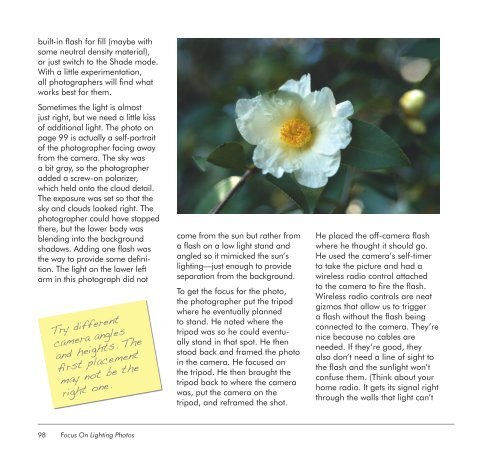Focus On Lighting Photos Focus on the Fundamentals.pdf
Create successful ePaper yourself
Turn your PDF publications into a flip-book with our unique Google optimized e-Paper software.
uilt-in flash for fill (maybe with<br />
some neutral density material),<br />
or just switch to <strong>the</strong> Shade mode.<br />
With a little experimentati<strong>on</strong>,<br />
all photographers will find what<br />
works best for <strong>the</strong>m.<br />
Sometimes <strong>the</strong> light is almost<br />
just right, but we need a little kiss<br />
of additi<strong>on</strong>al light. The photo <strong>on</strong><br />
page 99 is actually a self-portrait<br />
of <strong>the</strong> photographer facing away<br />
from <strong>the</strong> camera. The sky was<br />
a bit gray, so <strong>the</strong> photographer<br />
added a screw-<strong>on</strong> polarizer,<br />
which held <strong>on</strong>to <strong>the</strong> cloud detail.<br />
The exposure was set so that <strong>the</strong><br />
sky and clouds looked right. The<br />
photographer could have stopped<br />
<strong>the</strong>re, but <strong>the</strong> lower body was<br />
blending into <strong>the</strong> background<br />
shadows. Adding <strong>on</strong>e flash was<br />
<strong>the</strong> way to provide some definiti<strong>on</strong>.<br />
The light <strong>on</strong> <strong>the</strong> lower left<br />
arm in this photograph did not<br />
98<br />
Try different<br />
camera angles<br />
and heights. The<br />
first placement<br />
may not be <strong>the</strong><br />
right <strong>on</strong>e.<br />
<str<strong>on</strong>g>Focus</str<strong>on</strong>g> <str<strong>on</strong>g>On</str<strong>on</strong>g> <str<strong>on</strong>g>Lighting</str<strong>on</strong>g> <str<strong>on</strong>g>Photos</str<strong>on</strong>g><br />
come from <strong>the</strong> sun but ra<strong>the</strong>r from<br />
a flash <strong>on</strong> a low light stand and<br />
angled so it mimicked <strong>the</strong> sun’s<br />
lighting—just enough to provide<br />
separati<strong>on</strong> from <strong>the</strong> background.<br />
To get <strong>the</strong> focus for <strong>the</strong> photo,<br />
<strong>the</strong> photographer put <strong>the</strong> tripod<br />
where he eventually planned<br />
to stand. He noted where <strong>the</strong><br />
tripod was so he could eventually<br />
stand in that spot. He <strong>the</strong>n<br />
stood back and framed <strong>the</strong> photo<br />
in <strong>the</strong> camera. He focused <strong>on</strong><br />
<strong>the</strong> tripod. He <strong>the</strong>n brought <strong>the</strong><br />
tripod back to where <strong>the</strong> camera<br />
was, put <strong>the</strong> camera <strong>on</strong> <strong>the</strong><br />
tripod, and reframed <strong>the</strong> shot.<br />
He placed <strong>the</strong> off-camera flash<br />
where he thought it should go.<br />
He used <strong>the</strong> camera’s self-timer<br />
to take <strong>the</strong> picture and had a<br />
wireless radio c<strong>on</strong>trol attached<br />
to <strong>the</strong> camera to fire <strong>the</strong> flash.<br />
Wireless radio c<strong>on</strong>trols are neat<br />
gizmos that allow us to trigger<br />
a flash without <strong>the</strong> flash being<br />
c<strong>on</strong>nected to <strong>the</strong> camera. They’re<br />
nice because no cables are<br />
needed. If <strong>the</strong>y’re good, <strong>the</strong>y<br />
also d<strong>on</strong>’t need a line of sight to<br />
<strong>the</strong> flash and <strong>the</strong> sunlight w<strong>on</strong>’t<br />
c<strong>on</strong>fuse <strong>the</strong>m. (Think about your<br />
home radio. It gets its signal right<br />
through <strong>the</strong> walls that light can’t



